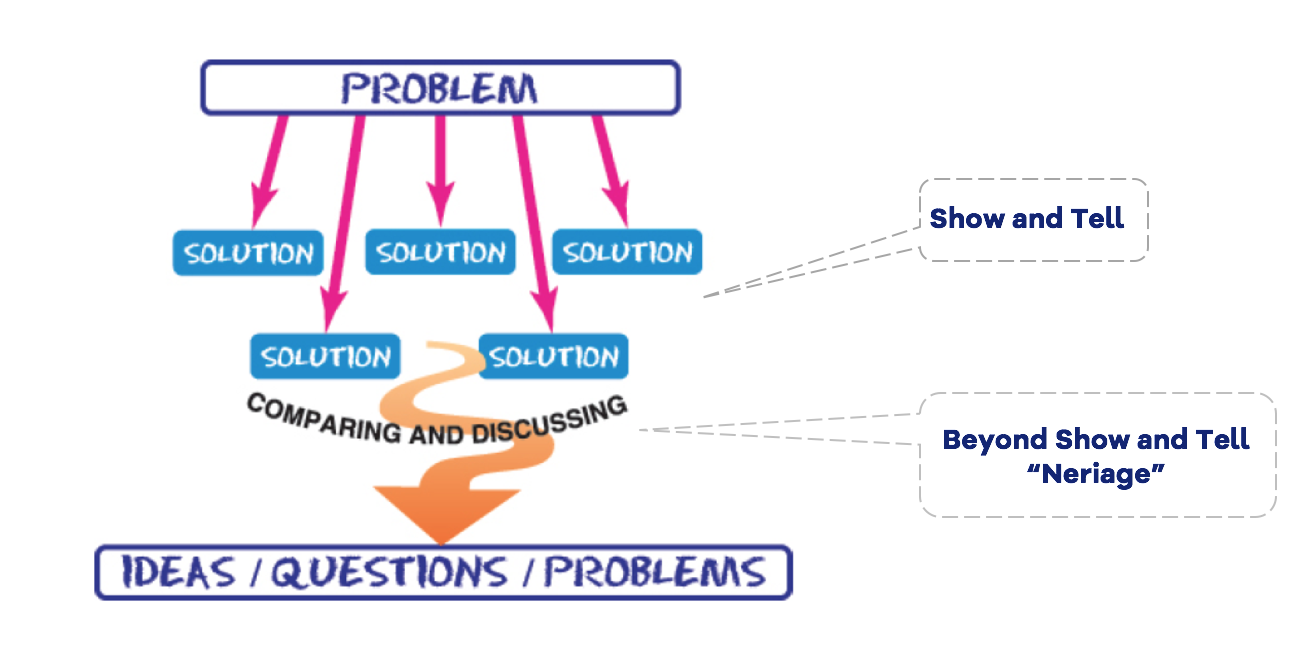The teacher should never say anything that a student could say.
—Akihiko TakahashiAssociate Professor of Elementary Mathematics, DePaul University, Chicago, IL
Speaking and Listening Routines
Teacher Questioning
A second powerful influence on student-led discussion is the questions that teachers ask, which provide a model for the questions that we hope students will internalize and will learn to ask on their own. Click on the arrows below to see examples of teacher questions during each phase of a TTP lesson and the purpose of questioning during each phase.
PURPOSE OF TEACHER QUESTIONING
Encourages students to:
- want to solve the problem
- notice what is similar or different from prior problems they have solved
- notice what is similar or different from prior problems they have solved
EXAMPLES OF TEACHER QUESTIONS
- What is the problem asking?
- What do we know that might help us solve this problem?
PURPOSE OF TEACHER QUESTIONING
Encourages students to:
- try to use what they know
- try to solve the problem using important reasoning tools (mathematical expressions, models, etc.)
- try to solve the problem using important reasoning tools (mathematical expressions, models, etc.)
EXAMPLES OF TEACHER QUESTIONS
- What do you know?
- What do the numbers in the problem mean?
- How do the numbers in the problem show up in your picture?
- How can you convince others?
- Can you write a mathematical expression for your method?
- Can you write a mathematical expression for your method?
PURPOSE OF TEACHER QUESTIONING
Encourages students to:
- understand classmates’ ideas and compare and connect them
- consider the accuracy, efficiency, and generalizability of presented ideas
- connect their own ideas with presented ideas
EXAMPLES OF TEACHER QUESTIONS
- How many solved it this way?
- Can you explain what Shavon did?
- Do you agree with this method?
- What is the same and different about Sam’s and Marika’s methods?
- What are the good points and difficulties of each solution method?
- Are there any more ways to solve this?
- Will this always be true?
PURPOSE OF TEACHER QUESTIONING
Encourages students to:
- summarize what they learned
- individually write about their own learning after hearing classmates’ summaries
EXAMPLES OF TEACHER QUESTIONS
- What did we learn today?
- How did my ideas change?
- What method used by a classmate do I want to try?
- What do I wonder about?
Students will internalize questioning only if they find it useful. The next section explores how to plan a discussion in which students’ presentations and questioning build the new mathematics of the lesson. When students experience insights and build new mathematical concepts through discussion of classmates’ work, they will be hooked on the power of questioning.
Neriage Discussion
Perhaps the most difficult aspect of a problem-solving lesson is neriage (pronounced nary-ah-gay) – a Japanese term for “kneading” or “polishing” students’ ideas through discussion. As shown in the figure below, neriage occurs after students come up with solutions to the problem. The point of a problem-solving lesson is not simply to solve the problem; it is to develop important new mathematical ideas through neriage that helps students build a bridge from their current solution methods to these mathematical ideas.
- What knowledge will students bring to the problem?
- What new understanding will they build during the lesson? (What actions or words will show their new understanding?)
- What experiences and insights will help students progress from their initial knowledge to the new understanding? For example, what do you expect students to learn from the task itself and from comparing different solution approaches?
- What specific features of different solution approaches will be important for students to notice? What questions will help students notice them?
Summary and Reflection
Following the neriage discussion, be sure to save time (at least 5 minutes) for the class to generate a lesson Summary, followed by time for students to write individually in their math journals about what they learned. The Summary can be initiated with a question like “What did we learn as a class today?” followed by sharing ideas. As you plan the neriage, you should have developed a clear statement of the summary you hope will emerge from the lesson, but it is powerful to use students’ own language to create the Summary on the board. If students do not summarize their learning in the way you hoped, this is powerful (if disappointing!) feedback for you.

